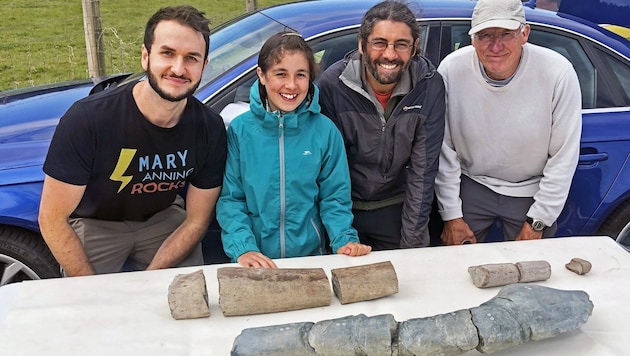Huge sea creature
Eleven-year-old finds remains of 25-meter reptile
The father-daughter duo certainly wouldn't have expected a find like this during their search for fossils. In the estuary of the River Severn, they came across the remains of a huge marine reptile. It is probably the largest marine reptile that has ever swum in the oceans.
"Please welcome Ichthyotitan severnensis, a giant ichthyosaur from the latest Triassic of the UK," wrote dinosaur expert Deam Lomax from the University of Manchester on X (formerly Twitter). The entire animal may have been more than 25 meters long, as he describes in the journal "PLOS One". The lower jaw bones alone were probably more than two meters long.
Bone discovery awakened memories
The fragments of a jawbone were found in 2020 by eleven-year-old Ruby Reynolds, who was looking for fossils with her father Justin on the beach at Blue Anchor in Somerset. The two recognized that the bones were similar to another find that had been described in 2018.
Eleven-year-old became a scientist
This impressed ichthyosaur expert Lomax so much that he invited her to join the research team that was to describe the find. Ruby was now a scientist with a publication to her name. Not only had she found a gigantic prehistoric reptile, she had also helped to name it, said Lomax. Its technical name is now Ichthyotitan severnensis, which can be translated as "giant fish lizard from the Severn".
Find put researchers on the right track
The lower jaw bone found by father and daughter Reynolds is more complete and better preserved than the one described in 2018. It confirmed some unique features of the bone fragments found first, whose location is about ten kilometers from Blue Anchor.
"It's quite remarkable that giant ichthyosaurs the size of a blue whale swam in the oceans around the UK during the Triassic," Lomax emphasizes. The Triassic is the oldest period of the Mesozoic Era; it began around 252 million years ago and ended around 201 million years ago.
Reptile of gigantic proportions
The reconstruction of the fragments revealed that the lower jaw bone was about 2.3 meters long. The authors of the study compared the bone with a lower jawbone of the ichthyosaur species Besanosaurus leptorhynchus, which was about 5.4 meters long. Distinctive features of the remains of Ichthyotitan severnensis were about five times as far apart as in the comparable Besanosaurus bone, so the scientists also assume that it was five times the body length.
"However, it is worth noting that this is based on fragmentary remains and therefore more complete specimens are required to confirm the giant size," they write.
Length could even be trumped
"These jawbones provide the tantalizing hint that perhaps one day a complete skull or skeleton of one of these giants could be found," Lomax said. It is even possible that the 25-meter length could then be surpassed: An examination of the bone tissue by a co-author of the study, Marcello Perillo from the University of Bonn, revealed that the ichthyosaur from Blue Anchor Beach was probably not even fully grown.
If the data is confirmed, Ichthyotitan severnensis would not only be the largest ichthyosaur species discovered to date, but also the youngest: the fossils come from a rock formation that is around 202 million years old - 13 million years less than previously known giant ichthyosaurs.
Dinosaurs were victims of the mass extinction
201 million years ago, at the end of the Triassic, the fifth largest mass extinction in the Earth's history occurred, which probably also claimed the lives of all the large ichthyosaurs. The marine reptiles never reached a comparable size again. They disappeared completely around 93 million years ago.













Kommentare
Willkommen in unserer Community! Eingehende Beiträge werden geprüft und anschließend veröffentlicht. Bitte achten Sie auf Einhaltung unserer Netiquette und AGB. Für ausführliche Diskussionen steht Ihnen ebenso das krone.at-Forum zur Verfügung. Hier können Sie das Community-Team via unserer Melde- und Abhilfestelle kontaktieren.
User-Beiträge geben nicht notwendigerweise die Meinung des Betreibers/der Redaktion bzw. von Krone Multimedia (KMM) wieder. In diesem Sinne distanziert sich die Redaktion/der Betreiber von den Inhalten in diesem Diskussionsforum. KMM behält sich insbesondere vor, gegen geltendes Recht verstoßende, den guten Sitten oder der Netiquette widersprechende bzw. dem Ansehen von KMM zuwiderlaufende Beiträge zu löschen, diesbezüglichen Schadenersatz gegenüber dem betreffenden User geltend zu machen, die Nutzer-Daten zu Zwecken der Rechtsverfolgung zu verwenden und strafrechtlich relevante Beiträge zur Anzeige zu bringen (siehe auch AGB). Hier können Sie das Community-Team via unserer Melde- und Abhilfestelle kontaktieren.